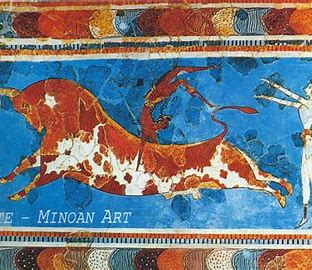Genetic Origins of the Minoans and Mycenaeans
I came across a very interesting article about the genetic origins of the Minoans and Mycenaeans. Because the original article was published in Nature magazine, I take its results seriously.
The Minoans were the first civilization to use underground clay pipes for sanitation and water supply, predating the Romans by 1500 years. They developed a complex urban culture that had canalization, sewage and storm water systems, as well as a form of water treatment. [1]
At Knossos Palace, the earliest known flushing toilet was developed. The toilets had screens to give privacy and were flushed by rainwater or water held in cisterns from conduits built into the wall. The Palace also had a drainage system with sinks and manholes. Archaeologists have found pipes buried from just below the surface to nearly 11 feet (3.35 meters) deep. The sewer system used terra cotta pipes 4-6 inches (10-15 cm) in diameter that had perfect socket joints, tapered so the narrow end of one pipe fixed tightly into the broad end of the next one. The tapering sections allowed a jetting action to prevent the accumulation of sediment in them. [2]
Palaces and even ordinary homes were heated with sophisticated hypocaust systems, where heat was conducted under the floor by gases from a fire or furnace, the earliest known of these systems to exist. [3]
The Mycenaean Civilization (approximately 1600 to 1100 BC) was the first advanced and distinctively Greek civilization on mainland Greece with its palatial states, urban organization, art and system of writing. This period was the time of the Trojan War and other heroic stories brought to us in Ancient Greek literature.
Below is the extract from the Nature article. The link to the article (which is normally behind a paywall) can be found in the article on the topic in the Greek Reporter piece linked after the extract. It is a detailed, scientific article, but for those with an interest in this topic, it is gold.
‘The origins of the Bronze Age Minoan and Mycenaean cultures have puzzled archaeologists for more than a century. We have assembled genome-wide data from 19 ancient individuals, including Minoans from Crete, Mycenaeans from mainland Greece, and their eastern neighbours from southwestern Anatolia. Here we show that Minoans and Mycenaeans were genetically similar, having at least three-quarters of their ancestry from the first Neolithic farmers of western Anatolia and the Aegean (1,2), and most of the remainder from ancient populations related to those of the Caucasus (3) and Iran (4,5). However, the Mycenaeans differed from Minoans in deriving additional ancestry from an ultimate source related to the hunter–gatherers of eastern Europe and Siberia (6–8), introduced via a proximal source related to the inhabitants of either the Eurasian steppe (1,6,9) or Armenia (4,9). Modern Greeks resemble the Mycenaeans, but with some additional dilution of the Early Neolithic ancestry. Our results support the idea of continuity but not isolation in the history of populations of the Aegean, before and after the time of its earliest civilizations.’
The link to the full article can be found in the following article:
DNA Analysis Reveals Minoan and Mycenaean Genetic Origins (greekreporter.com)
Sources
hypocaust | architecture | BritannicaMinoan Engineering – Plumbing and Heatiing: HistoryWiz Ancient Greece
